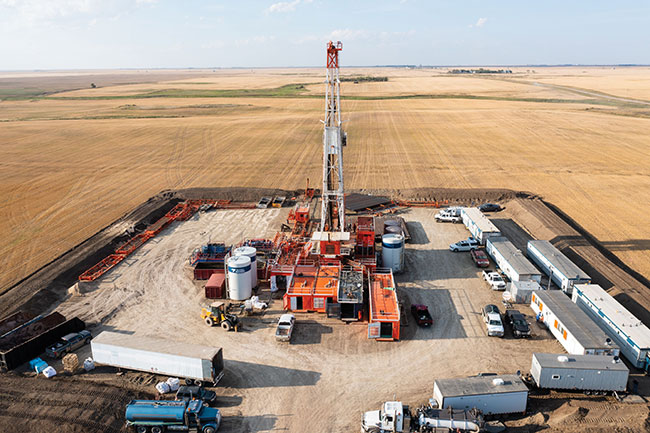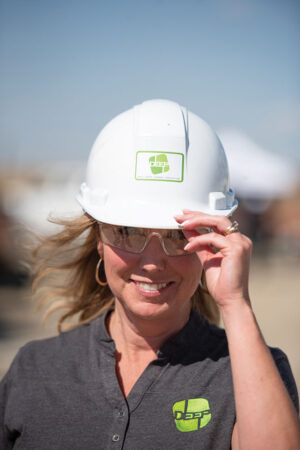
Features
Power from the ground up: The geothermal spectrum
Geothermal vs geoexchange – deciphering what’s possible with each technology.
August 29, 2022 By Greta Chiu
 The DEEP project in southeastern Saskatchewan is one of three major geothermal power projects in progress in Canada, and they’re looking for greenhouse growers to make use of the heat. Photo courtesy of DEEP and B. Zinchuk
The DEEP project in southeastern Saskatchewan is one of three major geothermal power projects in progress in Canada, and they’re looking for greenhouse growers to make use of the heat. Photo courtesy of DEEP and B. Zinchuk As greenhouse producers look towards a net zero carbon future, alternatives to fossil fuels start to look increasingly attractive, and geothermal is one of them.
But there’s still confusion around the terminology. Vice-president of Geothermal Canada and president of the geothermal power project, Alberta No. 1, geologist Catherine Hickson, PhD, says it has been and continues to be one of the biggest problems she’s faced in the sector over her 40-year career. Unbeknownst to many, the term “geothermal energy” actually points to a range of technologies, each with differing capabilities and costs.
“At the one extreme, we’re talking about drilling deep wells and bringing those brines to the surface,” she says. Known as “deep geothermal” or “conventional geothermal,” this technology taps into the earth’s intrinsic heat, often requiring the drilling of wells at least one to one-and-a-half kilometres into the earth. It can also take advantage of secondary heat, using the hot brine left from geothermal power generation of electricity.
At the other end of the technological spectrum is geoexchange, a form of shallow geothermal that uses the earth as a battery rather than a heat source. “We’re taking warm air and putting it into the subsurface [of the earth],” she says. “We still need to drill wells, but they’re very shallow – 60 metres, sometimes even less.” A closed-loop system, geoexchange typically takes anti-freeze or another fluid to carry the heat and circulate it through the pipes. “In the summertime, it’s hot, and the heat goes down into the ground. In the wintertime, it’s extracted and used for heating purposes.”
Conventional runs deep
When evaluating the site for potential deep geothermal projects, there are two pieces to consider: the type of rock and the temperature of the geothermal brine. Generally, the lower the temperature, the greater the amount of fluid that needs to be flowed.
Alberta, Saskatchewan and northeastern B.C. are rife with highly porous rocks such as sandstone and limestone, which allow oil and gas to be brought to the subsurface. “And it’s the same with the geothermal brine. It needs to flow through the rocks,” Hickson explains. This is also why conventional geothermal makes sense in these regions. “They’re in a sedimentary basin and there is a good possibility that they can extract warm fluids from the subsurface to use for heating through a heat exchanger.” There’s also a high geothermal gradient in these parts. “What we’re looking at are brines that are in the 40 to 90°C range. That’s heat we can extract.”
For other parts of Canada, particularly in Ontario and Quebec, the rock on the Canadian Shield is crystalline – mostly granite and high-grade metamorphic rocks that do not flow fluid. Here, the geothermal gradient is not nearly as high, making it less commercially feasible for deep geothermal. “We actually have to create what’s called an engineered geothermal system where we create fractured permeability and are able to flow a fluid through that fractured rock in order to extract the heat,” she says. “We’re pumping fluid down one well, moving it through the subsurface, then bringing it to the surface and extracting the heat. Then the whole cycle starts again.”

Catherine Hickson, PhD of the Alberta No.1 project
She knows of several companies in this space, each with their own proprietary technology. “Unfortunately, those are not yet shown to be commercially viable,” she says. “The drilling technology has been proven, but whether or not these have longevity, particularly in a crystalline rock context, has not been shown.”
Nunavut and the Yukon are mainly on crystalline rock as well. The Northwest Territories contain a fair bit of crystalline rock but has areas of sedimentary basin stretching up from further south.
In terms of capital expenditure, the drilling involved in deep geothermal takes the cake. “But that provides you with longevity, so the heat can be extracted over decades – 40 to 50 years or longer,” says Hickson. “High capital, but very sustainable, and with a very distant horizon. And that’s with good management.” As an added plus, the brines also contain CO2 that can be used by greenhouses – something she’s seen producers do in Iceland. For the more shallow geoexchange systems, she estimates that they would last at least 20 years, but at a lower capital cost.
Is geoexchange the right fit?
While deep geothermal power projects may be geologically constrained, the more shallow geoexchange technology can be largely deployed anywhere across the country. Using the earth to store heat extracted from the environment, these systems can be built horizontally or vertically underground. Whether geoexchange makes sense for a greenhouse, however, depends on the operation’s needs.
“With heat exchanger systems this is acting like a thermal battery,” explains Adam Alaica, P.Eng, director of engineering and development at GeoSource Energy. He emphasizes the importance of heat balance, using a bucket of water as an analogy. “If you want to ensure you always have water available, you need to be putting in what you take out. If you’re only draining water out of that bucket, at some point in the future you’re going to run into an issue where you don’t have water available. The same logic applies to ground heat exchangers for large applications…If you put too much in the ground, it also overflows. If you take too much out, the bucket empties.”
“The rules of the game are the same on the greenhouse side as the real estate side,” adds John Rathbone, P.Eng, president of Rathco ENG. Having worked with greenhouse clients, he’s observed how the cooling mechanism often involves opening the vents in a traditional glass-roof greenhouse. Using the same bucket analogy, he likens it to water being constantly removed but not replenished. “There’s no mechanism for us to put water back in the bucket, which basically eliminates the geoexchange system from being viable. You’ll start draining your bucket, but once that bucket is empty, you’ve now essentially frozen your bore field and it’s no longer useful.”
However, for warehouse-style, indoor growing environments with opaque roofing and supplemental lighting, Rathbone has worked on the modelling for a number of them and sees the opportunity. “In those types of systems…they are cooling-dominant. The amount of energy that those lights put into the space? The numbers are astronomically large.” The capital budget is then focused on the air conditioning or cooling equipment – even in the winter – to offset the heat from the lights. “It gets even more complicated when we start looking at the loads associated with the heat of evaporation of water and the transpiration process on the plants, but we model all of these variables. This is where a more balanced system can be applicable to indoor growing.”
Alaica agrees that a typical greenhouse that primarily needs heating and uses free-cooling could be very challenging for a conventional vertical ground source system. “Other types of technologies that could be a better fit may include surface water heating and cooling, aquifer-based heating or cooling, or even a horizontal system, which has inherently a little bit more leeway in terms of balance as it interacts more with outdoor air.”
“When you’re running a greenhouse that only requires heating, there’s nothing to balance it. As engineers we need to think about what makes the most sense based off of available resources on-site or other technologies to provide that balancing function,” he adds. One option may be to leverage the ground source system as a true thermal storage vessel, coupled to waste heat sources. In a solar thermal set-up, the sun’s energy could be stored in the ground over the summer. “You leverage that heat during the winter and you size that system so that the bucket is sufficient to manage the imbalance on an annual basis, with the input coming from the sun rather than from your cooling load or facility.”
Having worked largely with commercial and residential heating applications, Alaica notes that open loop systems are also possible with water sources, such as aquifers, surface water heating and cooling, as well as deep lake water cooling. For smaller greenhouse facilities in particular, their groundwater source could potentially serve a dual-purpose for both production and heat storage.
The cost of decarbonization
“In order for solutions to be economical, they really do need to be customized to the use case. This might be one of the many reasons why decarbonisation is not easy,” says Rathbone. “If you are a conventional greenhouse grower with a glass roof, your primary source of energy is going to be natural gas. And you’re going to take two commodities out of that – heat to heat your greenhouses and CO2 to enhance yield.”

John Rathbone, PEng of Rathco ENG
He notes how some facilities use large thermal energy storage tanks to save the heat generated from natural gas combustion, then release it at night after sunset. “All that works, but there is one giant elephant in the room called the carbon tax.” Based on planned legislation, Rathbone predicts that natural gas will hit $170 per tonne, if not more, by 2030 and beyond. “That [price] is going to be seen as the new floor, whereas now we see it as the ceiling. As a greenhouse operator, what do you do when you know the cost of energy is going to be increasing considerably?”
Although there are exemptions on natural gas use for greenhouse producers in most parts of Canada, whether the exemption will remain in place by 2030 is anyone’s guess. For those with combined heat and power (CHP) units, selling back to the grid may cause them to be labelled a power producer. “Any new natural gas power plant is going to pay the full carbon tax. When we modelled it out in terms of cost per kilowatt hour of producing electricity, the carbon tax was two-thirds of the cost,” Rathbone says, underscoring the importance of considering taxation in the decision-making process.
From his perspective, there are five major categories of cost-effective zero-carbon solutions at the moment – geothermal, biomass, industrial waste heat, sewer energy, and solar thermal. “Let’s not talk about hydrogen or nuclear because there just isn’t enough time between now and 2030, or arguably 2050, for these to become realistic, cost-effective at-scale solutions and technologies.”
For producers needing CO2 on top of heat and power, Rathbone’s top choice would be biomass. “If you are not needing the CO2, then a geoexchange or a deep geothermal system becomes a very compelling option, should your geology allow for it. But if you’re looking for CO2, there’s just one unfortunately at the moment.”
Once the carbon tax is factored in, their modelling has shown biomass to be cost-competitive with natural gas in combined heat and power production. “And that includes all the additional costs of transportation and storage of solid fuel. Not only are you not paying the carbon tax, but you’ve avoided a lot of other risks in terms of carbon policy, carbon pricing, and natural gas pricing.” In fact, going net-zero could open more doors to loans and grants. Working with several indoor cannabis producers in B.C., Rathbone’s energy conservation modelling work has helped them secure half a million in grants.
Because of the sheer volume of energy needed, Rathbone expects the carbon tax to hit producers hard. Three years ago, he and his team embarked on their first greenhouse project and it was eye-opening. “I thought we made a unit conversion error because the [energy] numbers were so large,” he says. It’s why he emphasizes the importance of understanding the risks and opportunities amid a changing energy landscape. This way, operators are better prepared to make decisions within the next year or two in how they could build out their infrastructure to support their business plans.
Last year, his team completed an eight-month pre-feasibility study with a greenhouse vegetable grower. If all goes according to plan, it could very well become the largest biomass-fueled CHP power plant in the world. They could sell the extra electricity and CO2 and potentially help decarbonize other greenhouses in the region as well. Pending additional studies, the build is projected at 240 acres per year for 10 years, with goals to begin construction in 2023.
At the end of the day, the choice of energy source comes down to the structure being heated, as well as its heating and cooling demands. Rathbone says it’s important to model those energy flows not only on an annual basis, but also on 20 to 30-year timelines.
Opportunities for collaboration
When it comes to conventional geothermal, there’s a difference between generating electricity versus heat.
To generate electricity, the brines typically need to reach at least 110°C, much more than what’s needed for heat only. From this high temperature fluid, thermal energy is extracted to produce power through an Organic Rankine Cycle (ORC) which creates electricity. However, the fluid post-ORC is still hot, albeit lower than what’s needed for generating electricity. Putting this cooler fluid through a heat exchanger then extracts the remaining heat for district or industrial heating, including greenhouses. Once the heat has dissipated, the cold flue, measuring below
20 °C, is injected back into the subsurface. “We’ve extracted every BTU of energy. It just makes absolute sense to have that secondary heat being used,” says Hickson.

Kirsten Marcia of DEEP Corp.
Currently there are three conventional geothermal power projects being developed and they are among the first to do so in Canada: the Tu Deh-Kah project in northeastern B.C., Alberta No. 1 in Greensview, and the DEEP project in southeastern Saskatchewan. All three have access to 120 °C brine within wells that run between two to four kilometres deep. More importantly, all have a large emphasis on food security, and Hickson hopes that they will be able to demonstrate the viability of using geothermal energy for greenhouses.
In the case of Alberta No. 1, Hickson says they’re actively seeking greenhouse growers who might have an interest in co-locating with their 10-megawatt project. “We’re in an area that is close to transportation on a rail line. It’s in northern Alberta where food security is a major driver.” Plus, they’ve already signed an MOU with Analeada, a company that uses earthworms to compost on an industrial scale, producing a product that is already being used by the greenhouse sector. “We just need to attract somebody.” Through their calculations, Hickson estimates that the available thermal energy would be enough to heat 50 to 80 acres of greenhouses.
As for the geothermal power project by DEEP Earth Energy Production Corp (DEEP) in Estevan, Sask., CEO Kirsten Marcia says they’ve already drilled six wells to date and signed a 25-year Power Purchase Agreement (PPA) for 5 MW with SaskPower and negotiations are ongoing for an enhanced PPA. They have completed feasibility engineering studies and plan to have the first 35-megawatt facility commissioning in early 2025. Four of these 35-megawatt facilities are being planned for a total of 140 megawatt of geothermal baseload power.
According to Marcia, even just one of the four planned facilities would be enough to power 35,000 households. As for the secondary heat, “with average insulation in southern Saskatchewan, this could heat a one square kilometre greenhouse,” says Marcia. “We would sell heat to that end user, discounted to the price of natural gas with no carbon tax. This is clean, renewable energy with 24/7 supply.”
Saskatchewan currently relies on coal for 40 per cent of its power, a source that is being phased out by 2030. With the downturn in oil and gas industries, people are looking for jobs, particularly in energy-focused regions of southern Saskatchewan. “Wouldn’t it be wonderful to have a career in the greenhouse industry?” Marcia proposes. “I’m from Estevan, and I’m passionate about the idea of economic diversification for this area. We think geothermal power generation married with end users – whether it’s greenhouses or aquaculture, you name it – that could create a huge energy ecosystem. Marrying clean energy with food security could be very impactful.”
In B.C., the Tu Deh-Kah Geothermal project, aims to provide seven to 15 megawatts of power. Previously known as the Clarke Lake Project, this initiative is led by the Fort Nelson First Nation community. Similar to the other two projects, there is a keen interest in using the waste heat for other purposes including increasing the region’s food security and potential for agricultural exports.
“We have to be big, in order to be cost effective. That’s why district heating, hectares of greenhouses – that scale of project is what we can do in deep conventional geothermal,” says Hickson.
In addition to collaborating with existing geothermal power projects, there is another possibility for lowering capital costs by taking advantage of pre-existing wells.
“We’ve put in a proposal to the federal government to look closely at suspended wells, and specifically in Alberta,” says Hickson. Differing from abandoned wells which have been plugged and sealed over by cement, thousands of paused or “suspended” wells currently exist in Alberta and could be re-entered for geothermal. “We’re going to look at not just the well temperature, but at proximity to roads, habitation, and an industrial park that might be appropriate for establishment of greenhouses or composting facilities.”
While electricity can be easily transported thousands of kilometers away via wires, heat will dissipate as it travels. For a greenhouse to use the heat from a suspended well, they would need to be located within a 10 km radius. “Part of our filter for this review is looking at the individual location of the well, drawing a 10-km circle around it, and seeing what’s [there].”
From deep geothermal to geoexchange systems, any would be potentially helpful to reducing greenhouse gas emissions, as well as reducing operating costs in time. “In Canada, you always have ground under your feet and you often have a lot of water available. There’s always going to be an application for geothermal in some shape, size or form,” says Alaica.
Elsewhere in the world
Greenhouses in the Netherlands and Iceland have successfully harnessed geothermal, but the situation is very different for both countries.
“The neat thing about the Netherlands … is it’s a low temperature resource, very similar to what we have in the western Canadian sedimentary basin,” says Catherine Hickson. “It’s actually lower temperature than what we’re dealing with, and in most cases, has no possibility of producing electricity, but it’s being used for direct heat.” Repurposing wells in close proximity, they also have hot brine as well as a much greater population density. “That’s why it works in the Netherlands.”
Having spent much time working in Iceland, Hickson has witnessed a stark change in locally grown produce. Where it might have been difficult to secure potatoes and onions in the early 90s, that is no longer the case today. “The greenhouse industry has taken off there and it’s due to accessibility to a high quality resource and a market.” With a population of around 350,000, this change wasn’t likely driven by domestic need as much as it was propelled by tourism with 1.5 million visitors per annum.
“The cost of our energy is much less expensive than in Europe,” adds John Rathbone. “We’re spoiled here in North America and even more so in Canada with [our] natural resources. It becomes a challenge to try and motivate companies and individuals to focus on decarbonization and not be wasteful with energy. What’s really moving the needle is the federal carbon tax.”
For more, watch the two-part geothermal webinar with Catherine Hickson and John Rathbone, available at greenhousecanada.com/webinars.
Print this page